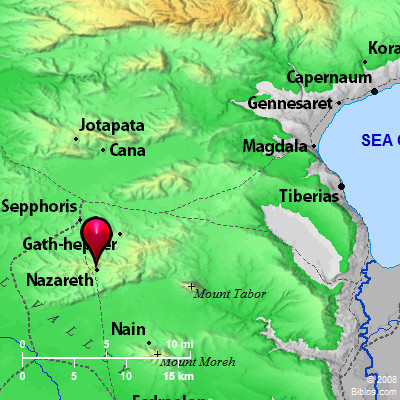Atlas  Nazareth and surrounding area Maps Created using Biblemapper 3.0 Additional data from OpenBible.info Occurrences Matthew 2:23 and came and lived in a city called Nazareth; that it might be fulfilled which was spoken through the prophets: "He will be called a Nazarene."Matthew 4:13 Leaving Nazareth, he came and lived in Capernaum, which is by the sea, in the region of Zebulun and Naphtali, Matthew 21:11 The multitudes said, "This is the prophet, Jesus, from Nazareth of Galilee." Matthew 26:71 When he had gone out onto the porch, someone else saw him, and said to those who were there, "This man also was with Jesus of Nazareth." Mark 1:9 It happened in those days, that Jesus came from Nazareth of Galilee, and was baptized by John in the Jordan. Mark 1:24 saying, "Ha! What do we have to do with you, Jesus, you Nazarene? Have you come to destroy us? I know you who you are: the Holy One of God!" Mark 10:47 When he heard that it was Jesus the Nazarene, he began to cry out, and say, "Jesus, you son of David, have mercy on me!" Mark 16:6 He said to them, "Don't be amazed. You seek Jesus, the Nazarene, who has been crucified. He has risen. He is not here. Behold, the place where they laid him! Luke 1:26 Now in the sixth month, the angel Gabriel was sent from God to a city of Galilee, named Nazareth, Luke 2:4 Joseph also went up from Galilee, out of the city of Nazareth, into Judea, to the city of David, which is called Bethlehem, because he was of the house and family of David; Luke 2:39 When they had accomplished all things that were according to the law of the Lord, they returned into Galilee, to their own city, Nazareth. Luke 2:51 And he went down with them, and came to Nazareth. He was subject to them, and his mother kept all these sayings in her heart. Luke 4:16 He came to Nazareth, where he had been brought up. He entered, as was his custom, into the synagogue on the Sabbath day, and stood up to read. Luke 4:34 saying, "Ah! what have we to do with you, Jesus of Nazareth? Have you come to destroy us? I know you who you are: the Holy One of God!" Luke 18:37 They told him that Jesus of Nazareth was passing by. Luke 24:19 He said to them, "What things?" They said to him, "The things concerning Jesus, the Nazarene, who was a prophet mighty in deed and word before God and all the people; John 1:45 Philip found Nathanael, and said to him, "We have found him, of whom Moses in the law, and the prophets, wrote: Jesus of Nazareth, the son of Joseph." John 1:46 Nathanael said to him, "Can any good thing come out of Nazareth?" Philip said to him, "Come and see." John 18:5 They answered him, "Jesus of Nazareth." Jesus said to them, "I am he." Judas also, who betrayed him, was standing with them. John 18:7 Again therefore he asked them, "Who are you looking for?" They said, "Jesus of Nazareth." John 19:19 Pilate wrote a title also, and put it on the cross. There was written, "JESUS OF NAZARETH, THE KING OF THE JEWS." Acts 3:6 But Peter said, "Silver and gold have I none, but what I have, that I give you. In the name of Jesus Christ of Nazareth, get up and walk!" Acts 4:10 be it known to you all, and to all the people of Israel, that in the name of Jesus Christ of Nazareth, whom you crucified, whom God raised from the dead, in him does this man stand here before you whole. Acts 6:14 For we have heard him say that this Jesus of Nazareth will destroy this place, and will change the customs which Moses delivered to us." Acts 10:38 even Jesus of Nazareth, how God anointed him with the Holy Spirit and with power, who went about doing good and healing all who were oppressed by the devil, for God was with him. Acts 22:8 I answered,'Who are you, Lord?' He said to me,'I am Jesus of Nazareth, whom you persecute.' Encyclopedia NAZARETHnaz'-a-reth (Nazaret, Nazareth, and other forms): Strong's Greek G3478: Nazara or Nazaret or NazarethNazareth, a city in Galilee |



